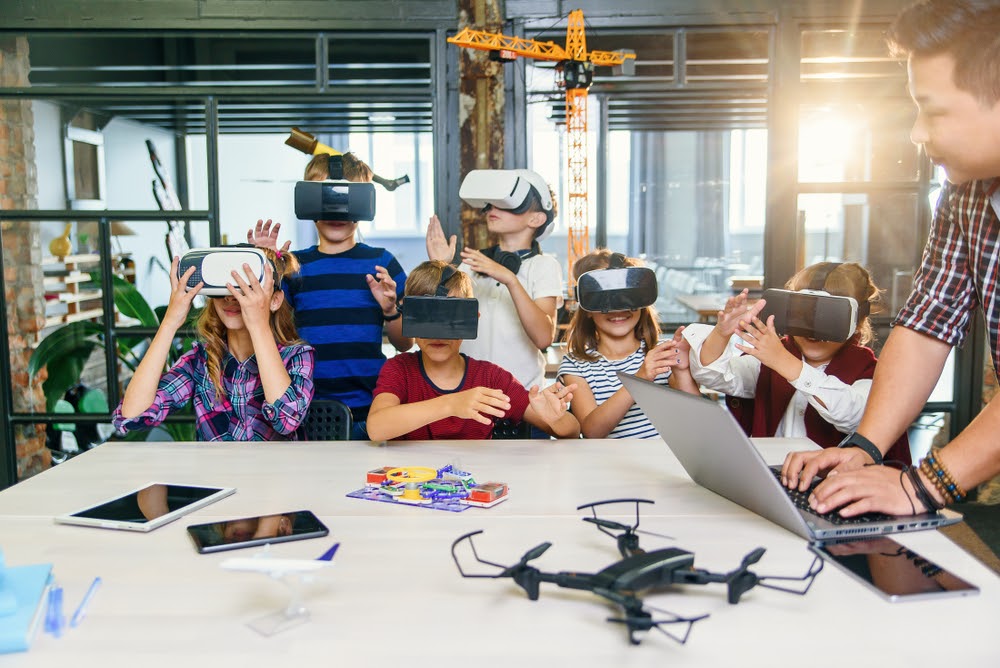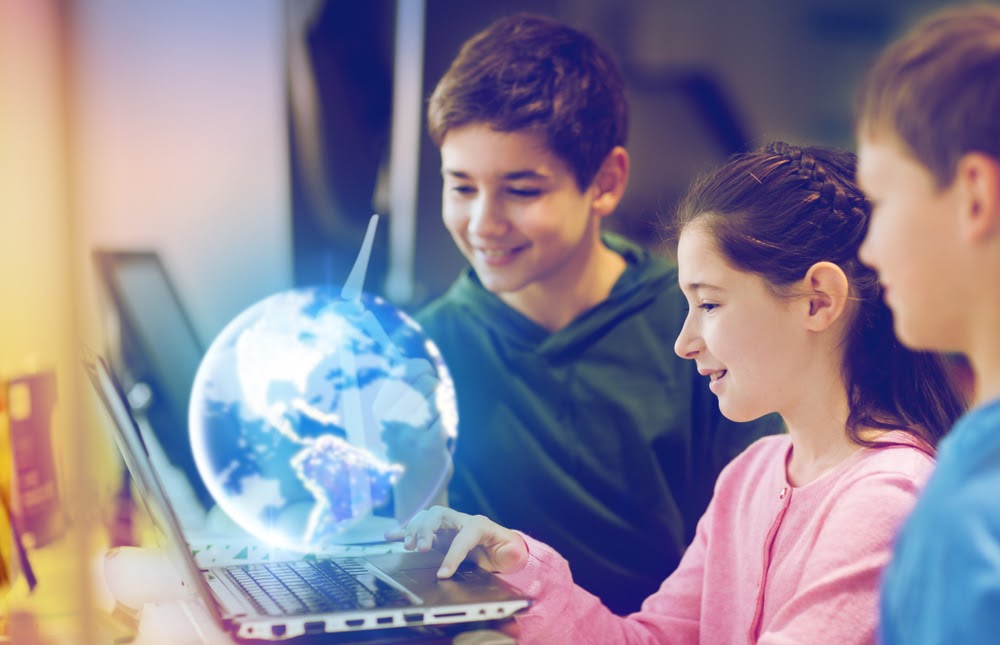How Do Schools Use Augmented Reality in Education?
Generations of students once remember using chalk and a blackboard to write out math problems and learn their alphabet. Those dusty boards then led to dry erase boards…which eventually morphed into smartboards.
Computers, too, were once a rare classroom feature. Today’s students often have their own laptop. Technology dominates the classroom, and lessons are becoming more immersive thanks to augmented reality and virtual reality platforms.
How do schools use augmented reality in education? The real question should be how DON’T schools use this technology! Augmented reality and virtual reality are used to enhance science lessons, to help students discover the universe and even to teach doctors about human anatomy.
Education is augmented, and technology is creating immersive experiences that enable students to explore and discover subjects like never before.
Automotive Education
Students learning to repair vehicles and other aspects of car mechanics are learning immersively thanks to the power of augmented reality.
In an interview with ABC Action News, one student explained that augmented reality allowed a safer learning environment as students navigated repairs of hybrid and electric vehicles. With augmented reality, the student explained, the steps were detailed and allowed full understanding of how to do the repairs…safely.
Augmented reality also is used by professional technicians. For example, Porsche technicians use “Tech Live Look,” which uses augmented reality glasses that feature lights to illuminate shaded areas and the glasses can even magnify tiny details. Glasses also are used by the techs to communicate to a tech team that can provide help during difficult repairs. The glasses show what the tech is seeing and show the image to the virtual team.
Mercedes-Benz also has implemented augmented reality to help technicians during repairs. Mercedes-Benz uses Microsoft HoloLens 2 headsets to communicate with a remote team, too. The headset also shows holograms and other instructions to help ease the repair process.

Medical Education
New York University’s Langone Health integrates augmented reality into the medical curriculum. The school offers a “Living Anatomy” course, which utilizes augmented reality to sub in for the dissection of cadavers. Instead, students learn with “photorealistic scanned cadavers and specimens.”
In addition, augmented reality lets students receive immersive instruction related to more difficult anatomy. And the school explains that faculty will create their own augmented reality models as well as augmented reality (or virtual reality) exercises.
Augmented reality also could theoretically be used to explore surgical education, too. As exercises and lessons are virtual and immersive, students could make mistakes without consequence. Augmented reality or virtual reality could let students safely explore procedures in a harmless environment via simulated experiences that are conducive to the medical school experience.
Elementary Education Augmented Reality
Younger generations—including Generation Z—have lived their entire lives with social media and, of course, the internet and computers. Navigating new technology is simply part of their lives and their social world.
Today’s elementary students often have their own laptop or notebook computer that links them to lessons and assignments. Schools also may utilize different programs that complement subject material. For example, reading programs may be used to help early readers gain fluency and confidence.
Augmented reality programs might be integrated into the curriculum, too. In fact, sites like Edutopia offer a list of programs that educators can use in their classrooms. Recommendations include:
CoSpaces Edu
This program enables students to create their own augmented reality experience.
Quiver Masks
Students create masks via augmented reality. These masks let students immerse in a story as a character or even an animal.
Narrator AR
This augmented reality program focuses on handwriting development. Letters come alive!
Wonderscope
Compatible with iOS, Wonderscope immerses children into stories by bringing the action and characters into the real environment. Parents can download this at home, too!

Virtual Reality in Education
Augmented reality might be the most accessible technology, as these experiences can be downloaded via phones. However, schools also are utilizing virtual reality to immerse students deeper into learning.
While augmented reality overlays graphics on top of the real environment, virtual reality takes the learning into another realm. Accessing virtual reality requires a headset, and this allows the user to enter the experience or lesson.
EdTech reports that virtual or augmented reality can allow students to improve their focus, and this is especially beneficial for children with ADHD who may become easily distracted. EdTech also interviewed a special education teacher who used virtual reality to deploy field trips for her students. With virtual reality headsets, her students were able to explore a greenhouse!
For some school districts, the price of headsets for virtual reality could pose an issue. However, these headsets allow students to access so many different experiences. Teachers could get extremely creative in using complementary virtual reality experiences with the subject lessons. For example, studying ancient Egypt could include a virtual tour of the Pyramids of Giza through virtual reality!

Augmented Reality in Education…at Home!
Parents whose children don’t utilize augmented or virtual reality in the classroom don’t have to be dismayed! Augmented reality experiences are plentiful for both Apple and Android devices. The App Store and Google Play offer a variety of ways to explore the world via augmented reality.
However, parents might wish to use augmented reality to complement their child’s lessons or subjects at school. As EdTech noted, children who have trouble focusing could benefit from augmented reality experiences for learning.
While there are too many apps to fully list, there are a few apps that are ideal for introducing children to augmented reality experiences. Parents don’t have to invest money for most of these apps; many are free, but a few may have a small price for download.
Also, if children or teens have a virtual reality headset like Oculus, they can explore many different experiences via Steam. Parents can do a search for educational virtual reality experiences. And they may even find virtual tour experiences, too!
Here are a list of 10 educational apps that are perfect for all ages; parents might have fun exploring, too!
JigSpace
This app is compatible with iOS. With JigSpace, students can create augmented reality experiences and presentations. This is a great way for students to learn how to create and explore with technology. Play around with different ideas, and encourage children to have fun! The app is recommended for children ages four and up…so even kindergarteners might have fun with it!
Catchy Words AR
With this game, children actually spell words in augmented reality! This is a fun way for children to practice both their spelling skills and their reading skills, too! Players have to catch the letters in their environment!
Augmented History
Don’t just learn about history…see it in the room. Or outside. Or anywhere. Augmented History shows castles and fortresses…and more! History appears before the user’s eyes!
Animal Safari AR
For younger children, augmented reality can be used to teach about animals from around the world. Drop different animals into the environment and read all about them.
Lessons in Herstory
This app focuses on famous women in history and uses augmented reality to help children learn all about them. But there’s a fun catch, too. To access the stories, students use their phone or device camera to capture a famous man’s photo in their school’s history book to learn about a woman with similar accomplishments!
GeoGebra Augmented Reality
Drop 3D images in the environment. These math images can be explored from any and every angle to help students understand concepts beyond the book.
AugmentedClass
This app is available for Android devices and enables students to create their own augmented reality experiences. No programming or coding experience is necessary, which makes this app perfect for students who want to learn more about designing their own augmented reality.
Civilisations AR
This app from the BBC brings ancient objects and art into an immersive augmented reality experience. Explore Renaissance artwork and a mummy from ancient Egypt.
Seek
Encourage children and teens to explore the world around them with Seek. Developed by iNaturalist, this app lets users scan an image of a plant, animal or an insect from their environment to learn more about their own backyard…or any surroundings. In a few seconds, the app will identify the exact species and provide more details. This is a great app to use on vacation to explore the native flora and fauna of any region.
SkyView Lite
Students can view the night sky anywhere in their home. Or just point the camera at the sky using the app to learn more about the constellations and heavenly bodies in the sky. The app will even identify planets! When using SkyView at night, users can select night mode for better viewing.
As augmented reality progresses in its development, more schools and classrooms may utilize this technology as a complementary learning tool for specific lessons and subject matters. For example, medical schools might opt to use augmented reality in place of cadaver dissection or as a means to help early medical students gain experience with specific anatomical features in the body. Elementary schools can use augmented reality to enhance the learning experience and to help students zero in on a lesson to minimize distractions.
While virtual reality requires a headset to experience lessons, games and simulations, augmented reality is much more accessible. Parents can download augmented reality apps for their children to encourage them to immerse in science, math and history topics. These apps are often free and many are recommended for all ages.
In the future, augmented reality could become yet another tool that educators use to encourage exploration and help immerse children in the lesson and curricula. With augmented reality and even virtual reality, students can visit faraway countries, see dinosaurs appear before their eyes and even view constellations from the sky…all without even leaving the classroom!
Recent Posts
Categories
Luxury Cars
Trucks
Sedans
